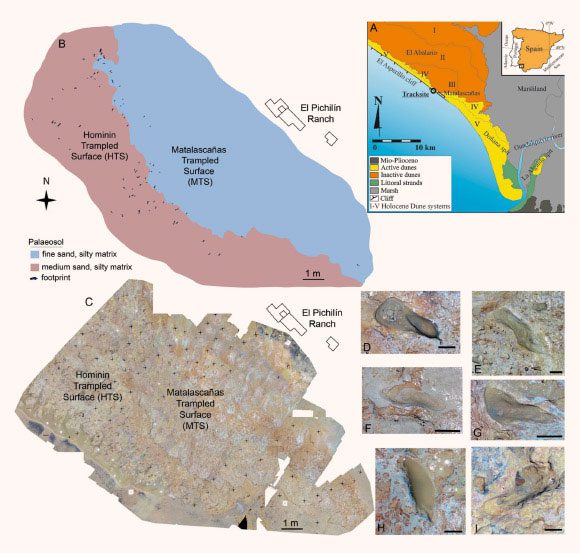The ghostly footprints of juvenile individuals imprinted on the El Asperillo cliffs in Doñana National Park (Spain) have been confirmed not to belong to modern Homo sapiens.
These ancient “ghosts” appear in the form of 87 fossilized footprints, of which 31 are complete and range in size from 14 to 29 cm, indicating that their owners were approximately 104 to 188 cm tall.
According to a study recently published in Scientific Reports, the creators of these ghostly traces are likely Neanderthals, our distant relatives from a different species than Homo sapiens.

A close-up of the “ghost” footprints indicating the existence of a Neanderthal community dominated by juvenile individuals – (Photo: SCIENTIFIC REPORTS).
“The size diversity of the footprints suggests the existence of a social group of hominins dominated by juveniles” – the Sci-News quoted the researchers’ analysis.
The lead author, Dr. Eduardo Mayoral from the Department of Earth Sciences at the University of Huelva (Spain), stated: “The footprints of hominins are usually identified based on anatomical features. Identifying hominin footprints for a specific species often relies on indirect evidence.”
Dr. Mayoral’s team linked these ghostly footprints to nearby archaeological assemblages and remains, as well as to the broader region.
They also utilized a new technique called optically stimulated luminescence to accurately date these fossilized footprints to be 295,800 years old. “The chronological context may indicate that Neanderthals were the creators of these footprints” – the researchers noted.
Fossilized footprints may not attract global attention like skeletal remains, but they hold significant meaning in science. While skeletal remains are static, footprints can reveal where these individuals were headed, under what weather conditions, how they walked, and even the actions they were performing when they inadvertently left ghostly prints on the rock.
“It allows for discussions about the ecological role of this ancient community and the evolutionary context during a favorable climatic period” – the research team reflected.
This discovery also provides important insights into human occupations in Europe during the Pleistocene epoch, an intriguing era when our species slowly began to establish primitive societies as a distinct group among many other human species that later went extinct.
Neanderthals were among our last companions. Many of us still carry their blood, a result of interbreeding that has long been suspected to contribute to the extinction of Neanderthals (around 30,000-40,000 years ago).


















































